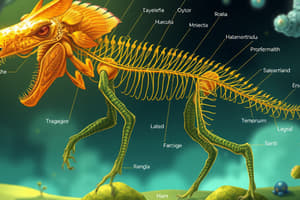Podcast
Questions and Answers
What is the grouping of organisms based on a set of criteria?
What is the grouping of organisms based on a set of criteria?
classification
Who created Linnaeus's System?
Who created Linnaeus's System?
Carolus Linnaeus
What discipline of biology is primarily concerned with identifying, naming, and classifying species based on natural relationships?
What discipline of biology is primarily concerned with identifying, naming, and classifying species based on natural relationships?
taxonomy
What system gives each species a scientific name that has two parts?
What system gives each species a scientific name that has two parts?
What is a named group of organisms called?
What is a named group of organisms called?
What is defined as a group of species that are closely related and share a common ancestor?
What is defined as a group of species that are closely related and share a common ancestor?
What term describes the next higher taxon or genus, consisting of similar, related genera?
What term describes the next higher taxon or genus, consisting of similar, related genera?
What taxonomic rank contains related families?
What taxonomic rank contains related families?
What taxonomic rank contains related orders?
What taxonomic rank contains related orders?
What taxonomic rank contains related classes?
What taxonomic rank contains related classes?
What is composed of related phyla or divisions?
What is composed of related phyla or divisions?
What taxonomic rank is the broadest of all and contains one or more kingdoms?
What taxonomic rank is the broadest of all and contains one or more kingdoms?
What are the three domains?
What are the three domains?
What are the six kingdoms?
What are the six kingdoms?
What type of prokaryotes has cell walls containing peptidoglycan?
What type of prokaryotes has cell walls containing peptidoglycan?
What are prokaryotes whose cell walls do not contain peptidoglycan?
What are prokaryotes whose cell walls do not contain peptidoglycan?
What is the process called when a cell divides into two genetically identical cells?
What is the process called when a cell divides into two genetically identical cells?
What is it called when two prokaryotes combine genetic information via pili?
What is it called when two prokaryotes combine genetic information via pili?
What are the three types of bacteria?
What are the three types of bacteria?
What is a dormant bacteria cell able to survive for long periods under harsh environmental conditions called?
What is a dormant bacteria cell able to survive for long periods under harsh environmental conditions called?
What is a nonliving strand of genetic material within a protein coat called?
What is a nonliving strand of genetic material within a protein coat called?
The host cell makes copies of the viral DNA or RNA and extra protein capsids; what is this process called?
The host cell makes copies of the viral DNA or RNA and extra protein capsids; what is this process called?
Which cycle is associated with the integration of viral DNA into a host's DNA?
Which cycle is associated with the integration of viral DNA into a host's DNA?
What kind of virus contains RNA instead of DNA?
What kind of virus contains RNA instead of DNA?
What is a protein that can cause infection or disease called?
What is a protein that can cause infection or disease called?
What type of organisms are classified as Protists?
What type of organisms are classified as Protists?
What describes heterotrophic, unicellular, animal-like protists?
What describes heterotrophic, unicellular, animal-like protists?
What is commonly known as algae and primarily consists of autotrophs?
What is commonly known as algae and primarily consists of autotrophs?
What are the characteristics of fungi?
What are the characteristics of fungi?
What structure in fungi is the reproductive structure that appears above ground?
What structure in fungi is the reproductive structure that appears above ground?
What term describes specialized hyphae that grow into a host's tissue to feed?
What term describes specialized hyphae that grow into a host's tissue to feed?
What is the correct way for scientific names to be written?
What is the correct way for scientific names to be written?
What are the characteristics an organism must have to be a member of Kingdom Protista?
What are the characteristics an organism must have to be a member of Kingdom Protista?
Flashcards are hidden until you start studying
Study Notes
Classification and Taxonomy
- Classification groups organisms based on shared characteristics.
- Carolus Linnaeus developed the first formal classification system.
- Taxonomy identifies, names, and categorizes species based on natural relationships.
- Binomial nomenclature assigns a two-part scientific name: genus and species.
- A taxon refers to any group of organisms that share a common identity.
Taxonomic Ranks
- Genus includes closely related species sharing a common ancestor.
- Family comprises related genera.
- Order consists of related families.
- Class encompasses related orders.
- Phylum (or division) contains related classes.
- Kingdom includes multiple phyla or divisions.
- Domain is the broadest taxon category, incorporating one or more kingdoms.
Domains and Kingdoms
- Three domains exist: Bacteria, Archaea, and Eukarya.
- Six kingdoms include: Eubacteria, Archaea, Protista, Fungi, Plantae, Animalia.
- Domain Bacteria represents prokaryotes with peptidoglycan cell walls.
- Domain Archaea includes prokaryotes without peptidoglycan, found in extreme conditions.
- Domain Eukarya features eukaryotes, which can be unicellular or multicellular.
Characteristics of Domains and Kingdoms
- Kingdom Fungi consists of eukaryotic organisms that absorb nutrients and lack mobility.
- Kingdom Plantae is made up of multicellular eukaryotes with cellulose cell walls.
- Kingdom Animalia contains multicellular eukaryotes without cell walls, organized into tissues.
Bacterial Structure and Reproduction
- Bacteria are microscopic prokaryotes characterized by structures like nucleoid, pili, capsule, and flagella.
- Bacterial chromosomes are circular and found in the nucleoid.
- Binary fission is the process by which bacteria replicate into two genetically identical cells.
- Conjugation involves the exchange of genetic material between two bacterial cells.
Bacterial Metabolism and Survival
- Bacteria can be photoautotrophs (photosynthesis), chemoautotrophs (chemosynthesis), aerobes (require oxygen), or anaerobes (do not need oxygen).
- Survival endospores allow bacteria to endure harsh environmental conditions.
Viruses
- Viruses consist of a nonliving strand of genetic material encased in a protein coat (capsid).
- The lytic cycle involves immediate viral gene expression after infection, resulting in new virus assembly and host cell lysis.
- The lysogenic cycle integrates viral DNA into the host's genome, remaining dormant before triggering the lytic cycle.
- Retroviruses contain RNA and exhibit complex replication cycles.
Prions and Protists
- Prions are infectious proteins that can cause disease and cause other proteins to mutate.
- Protists are diverse eukaryotes that can behave as plant-like, animal-like, or fungus-like organisms, often living in aquatic environments.
Fungi Characteristics
- Fungi are eukaryotic, with cell walls made of chitin and lacking chloroplasts.
- Reproduction occurs asexually (budding, fragmentation) and sexually (spore production).
- Fungi obtain nutrients as saprophytes (decomposers), parasites, or mutualists associated with plants.
Nutritional Modes of Fungi
- Saprophytic fungi decompose dead organic material.
- Parasitic fungi feed on living cells, using specialized hyphae called haustoria to penetrate host tissues.
- Mutualistic fungi benefit from symbiotic relationships with plants, aiding in nutrient absorption.
Classification Criteria
- Organisms are classified based on cell type and structure.
- Protistas are eukaryotic and cannot form organs, distinguishing them in the biological classification system.
- Viruses lack cellular structure, leading to their exclusion from traditional biological classification.
Studying That Suits You
Use AI to generate personalized quizzes and flashcards to suit your learning preferences.





